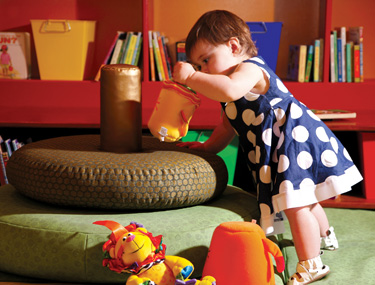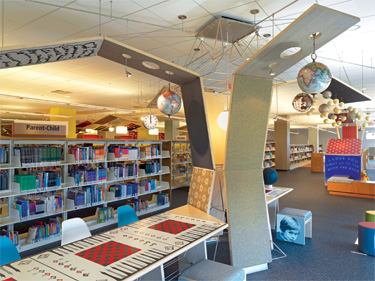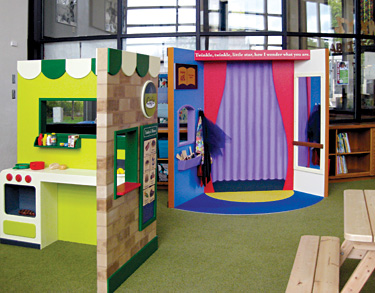Design to Learn By: Dynamic Early Learning Spaces in Public Libraries

Young patrons at the Warrensville branch of the Cuyahoga County (OH) Public Library.
A toddler explores the enclosed crawler space. Another child engages with one of many play
elements geared to build literacy. Roger Mastroianni Photography
A design revolution is reinventing the children’s room in public libraries and changing the way young children learn.
The movement involves colorful spaces with mirrors, soft edges, and things to climb on. There are items to play with such as “sentence makers” and audio-based toys. A farmer’s market, cash register, automobile, or airport may be involved. Most importantly, the areas are embedded with tools and features that get kids ready to read.
This new breed of literacy-packed play spaces in libraries is inspired by children’s museums and the developmental theories that drive them. “You can call it interaction, you can call it theme design,” says Sharon Exley, a designer and president of Architecture is Fun, a firm that has conceived spaces for both libraries and children’s museums. “We’re creating architecture in a way that children understand,” she adds. “The underlying story or framework is always literacy, and how you make it fun and playful.”
Bite-sized children’s museums
Tracy Strobel strived for a rich learning experience that would keep patrons coming back when she was conceiving new children’s areas for the Cuyahoga County (OH) Public Library (CCPL), now in the midst of a system-wide rebuilding and renovation project. Strobel, deputy director at CCPL, imagined “bite-sized pieces of a children’s museum” that kids and their caregivers or parents would visit weekly or once a month. They would be “destinations for families much in the way that a children’s museum is a destination,” she says.

The garden-themed toddler area at the Evanston (IL)
Public Library has ample seating for caregivers.
Photo by Doug Snower Photography
While planning the nine new children’s areas, each at roughly 8,000 square feet, Strobel zeroed in on what they needed to offer children educationally. The designs, she notes, had to be “related to the six early literacy skills” identified by literacy experts and adapted by educators: developing vocabulary, print recognition, print awareness, narrative adeptness, letter knowledge, and phonological awareness. Strobel handed potential architects and designers a sheet outlining these and other key requirements. At the same time, she adds, “we try really hard to have a variety of elements at the different spaces.”
Enter the design firm RedBox Workshop, which is conceiving, fabricating, and installing some of the new areas at CCPL. “You’re basically teaching experiential learning through play,” explains Tony LaBrosse, partner and director of design and project management at RedBox. The company has also created play areas at museums, zoos, and hospitals.
In the libraries, at least, books still reign, but the heart of the project was “applying an aesthetic wrapper to early literacy objectives,” says LaBrosse. Many CCPL spaces are built around themes from children’s books. The Warrensville branch environment, for one, was inspired by Ashley Bryan’s book Let it Shine: Three Favorite Spirituals (Atheneum, 2007), with its vibrant, cut-paper illustrations. The library walls, decorated with dancing silhouettes like those in Bryan’s book, do indeed create a vibrant sense of play that riffs on the heart of the literature in the room.

An Evanston patron with cushions
that double as a classic stacking toy.
Photo by Doug Snower Photography
A centerpiece of the new features is an enclosed “crawler space,” as Strobel calls it—a safe, enclosed play pit for the littlest patrons, stocked with stimulating, brightly colored motifs. Nearby, a light board allows pre-literate kids to assemble stories with different Colorform shapes, honing narrative adeptness. A sound board spells out words broken into syllables. When a child pushes a button, he hears an individual syllable pronounced. In a nearby mirror, he can watch himself forming the syllables.
A “sentence maker” also builds print awareness with elements that kids can spin or move up and down to reveal random words forming “wacky sentences,” says CCPL marketing and communications director Hallie Rich.
Elements like these, LaBrosse explains, are about “meeting the individual or group where they’re at on any given day.” He says, “We don’t try to set up an experience that is ‘you will learn this today when you go do that experience.’ We’re not here to judge their learning experience. We don’t have an outcome. We’re not grading.” The designs also “try to create age-appropriate risk” such as exploring—and probably taking a tumble—without getting hurt.
The children’s area at CCPL’s new Mayfield branch takes inspiration from Denise Fleming’s Caldecott Honor book In the Small Small Pond (Holt, 1993). Adopting the idea of wetlands exploration,the space incorporates “science work related to tadpoles or microscopic science with early literacy,” says LaBrosse. There’s a microscope, an insect observation center with large bugs on view, and a soundboard.
Other spaces are purely thematic. At Garfield Heights, it’s all about cars. There’s a garage and a gas pump, levers and pulleys to play with, and toy spark plugs, all of which can be manipulated to boost STEM skills, a priority of the local school system, says Strobel. The Fairview branch takes on the concept of travel, with world landmarks, a play airplane hangar, and control tower. There’s a ticketing and baggage area, along with places to sell food, and a cash register. The environment “allows kids to do all this imaginative play with time, tools, and small motor skills,” says Strobel.
Lamaze and play-based pavilions
The best way to engage early learners, says Exley, is through “literacy-rich and play-based pavilions that allow children to explore” and navigate the world of reading.
She and her partner at Architecture is Fun, husband and architect Peter Exley, kept these child-centered questions in mind while conceptualizing a renovation for the 14,500-square-foot children’s area for the Evanston (IL) Public Library in 2007 and a new, nearly 16,000-square-foot space for the Fountaindale (IL) Public Library in 2011.
Developmental theory is always at the forefront of Exley’s mind. While dreaming up spaces for very young children, she thinks about psychologist Abraham Maslow’s “Hierarchy of Needs,” a theory of psychological health. The basic idea is that a fundamental feeling of safety and security enables relationships, esteem, and creative potential.
For Exley, this translates into crawler spaces offering stimulation and security. “Sensory gardens, little padded landscapes, things on the ceiling to focus on” are key elements for the youngest library patrons, Exley says. The soft, colorful elements also offer “Lamaze-style iconography.”
At Evanston, the “garden of early learning,” like Warrenville’s crawler spot, is such a place. It is an enclosed area with playful plant and flower motifs—gingko leaves and stylized roses based on a Charles Rennie Macintosh design. Inside, oversized cushions function as a “classic stacking toy, but we’ve done it as a giant soft sculpture,” says Exley. “If a child is learning to walk or stand, it gives them something to hold on to.”
Elsewhere at Evanston, where the Exleys’ elements were fabricated and installed by RedBox, is a little collection of “storytelling sticks,” resembling garden signs, that can be written on. “Very often preschoolers tell a little story to teachers who write it down and parents get this at the end of the day,” says Exley. To build on kids’ articulation skills, “parents can jot down a thought shared by their child.”

A game pavilion at the Fountaindale (IL) Public Library.
Photo by Doug Snower Photography
For older children, the Exleys conceived tables with built-in bins for art supplies and play items such as LEGO. Branching columns rise from the tables, a nod to architect Frank Lloyd Wright. The overhanging limbs are outfitted with holes that librarians can suspend things from—origami, artwork, globes, or whatever else may be related to the project of the moment. The art area has a built-in sink for washing up. This place is made for action.
The Fountaindale children’s area took its cue from a children’s book, Dragon Tree by Jane Langton (HarperCollins, 2008). With lots of room to move, the team created a “mini-park” with stylized trees arranged to “call out these areas of adventure or discovery,” Exley says.
Those areas include a spot for playing global games, with real globes and one painted with blackboard paint, so kids can draw their own world. A “garden of technology” has informational monitors suspended from trees. There’s a crawler area here, too, and a space for the chess club. In the art area, the trees are equipped with clips for displaying completed art projects.
Exley stresses that libraries considering play-centered areas should be mindful of designing one they can manage. You want an area that “the staff can afford” and maintain. Fountaindale manager of children’s services Wendy Birkemeier says that because of graffiti issues, she doesn’t usually leave chalk out in the library. Her staff puts out washable crayons instead.
More conceptually, Exley returns to the central exploratory aspect of such early learning areas. “You don’t want to have an interactive environment that’s push-button,” she says. “You need something open-ended.”
“Family Play and Learning Spots”
The Hennepin County (MN) Library (HCL) launched its first early literacy play area in 2010, when the Minnesota Children’s Museum received an Institute of Museum and Library Services (IMLS) grant to explore the idea of designing early literacy play spaces within libraries. HCL has adopted two of these spaces so far, geared to children ages two to six, at the Hopkins and North Regional branches, with another opening this fall.
“The idea was that children’s museums have great ideas about exhibit design and ways for parents and children to interact around play,” says Maureen Hartman, coordinating librarian, youth programs and services at HCL, of the new 400- to 700-square foot areas. “That’s a really different direction for libraries.” She adds, “We have supported our staff with play training that the children’s museum has offered us.”
On any given day at one of these play spots, you’ll find children busily working in a fabricated garden, made of two pieces of leather with cotton underneath, planting imaginary seeds in a row. One might plunk an illustrated sign reading “carrot” into the ground, cook toy carrots in a play kitchen, and serve them up at a mini café table. Nearby, at a toy farmer’s market, children can sort, count, and identify more vegetables. All this fun is bolstering their vocabulary and reading and honing narration and numeracy abilities.
To inform and support caregivers, “directions and cues to parents” are posted at the early literacy spaces, Hartman says. HCL also produced a document for adults outlining five simple things that they can do to help get kids ready to read, based on the Every Child Ready to Read (ECRR) principles issued by the Public Library Association (PLA): “talk, sing, read, write and play together.”

A play kitchen and mini theater at the North Regional branch of the Hennepin County (MN) Library. The Hennepin system’s early learning spots are oriented to children ages two to six and resulted from a collaboration with the Minnesota Children’s Museum.
Photo Courtesy of Hennepin County Library
“Playing is how kids learn,” the document tells readers. “Playing in a space like this helps kids use their imagination to solve problems—it also helps them learn to work with others and prepares them to learn and read.”
For now, HCL is calling these new areas “Family Play and Learning Spots,” according to Hartman. HCL is working with the Minnesota Children’s Museum and the Minnesota Center for Early Education and Development on an evaluation of the impact these types of areas have within libraries. “I’m really interested in a pre- and post- test,” says Hartman. “What does engagement look like between parents with children in a regular library vs. one that’s more thoughtfully planned?”
Answers to that question, and others, will be revealed when the study is completed this fall. Hartman says she will use the findings to leverage support for more play spaces.
In the meantime, the people who help conceive and build these educational hot spots never stop wondering how spatial design can better support literacy and development. “Some designers look at things in two dimensions, like how long you want your desk to be,” Exley says. “We like to think in a four-dimensional way. We come in to add the experience level—in 4D.”
Sarah Bayliss has contributed to SLJ, LJ, and LJ’s Library by Design supplement. She has also written about museums and design for ARTnews and other publications.
RELATED
The job outlook in 2030: Librarians will be in demand
The job outlook in 2030: Librarians will be in demand
ALREADY A SUBSCRIBER? LOG IN
We are currently offering this content for free. Sign up now to activate your personal profile, where you can save articles for future viewing





Add Comment :-
Comment Policy:
Comment should not be empty !!!
Mary Jennings
I liked your article on libraries as museums, but the picture you chose for the Warrensville library was posed and inaccurate since the Warrensville Heights, Ohio community is 95% African American, why can't the children the library was built for be shown enjoying it?Posted : Sep 02, 2013 01:33
Eusebia Milanes
WoW! I love all this 'nuevas ideas"Posted : Aug 13, 2013 08:58